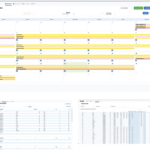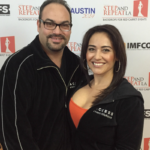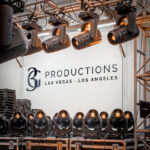Catapulted? Ignited? Skyrocketed? Erupted? What is the best word to describe a company that, in a scant ten years, went from a two-car garage to a three-car garage to a 5,000-square-foot warehouse to a 12,000-square-foot facility and is now occupies 27,000 square feet with more than 25 employees? Begun in May 2004 by Sara B. Knutson and Ryan Knutson, Brown Note Productions of Thornton, Colorado, is a supermarket of services, support and sales for live event audio, video and lighting. Like most successes, the enterprise began with a simple idea.
Getting Started
“I was a corporate events manager for a data storage company,” recounts Sara, “and Ryan had just gotten off the road after several years with a band that he worked with. The company was preparing for a big meeting that needed audio-visual production and gave me the project. I took the equipment list from the previous meeting home and reviewed it with Ryan. He had the idea that we could probably scrounge enough money to buy the necessary gear and, because the company did the event every few months, have it paid off quickly. So we created a company called Brown Note Productions and made up a formal-looking estimate on Excel. I took that to my boss as my recommendation for the job, and he approved it. We gathered up every nickel, dime and penny we could to buy the equipment — mounted speakers, lights, microphones, projector, screen, a little mixing board — and suddenly we were in the event business!”
 Meanwhile, Ryan got an assignment as a monitor engineer with a band called Sound Tribe Sector 9. A friend who worked at Digidesign (now Avid) invited him to the AES convention in San Francisco to see their new digital audio console, the Venue Console. “He told me,” recalls Ryan, “‘You’ve got to come see this board, it’s going to revolutionize the industry. It’s fully integrated, with Pro Tools and plug-ins and all the things artists are using in their studios.’ One of their sales managers really liked the band I was working with and let us demo the desk on the road. Sure enough, I fell in love with it. I went ahead and purchased one, which we rented back to the client I was touring with. We were one of the first in the industry to have this new console, which really helped our business expand from local, corporate events to national tours. We still own that board today. It’s still in great working condition and gets sent out on tours and festivals and everything under the sun. We actually own 14 of them now.”
Meanwhile, Ryan got an assignment as a monitor engineer with a band called Sound Tribe Sector 9. A friend who worked at Digidesign (now Avid) invited him to the AES convention in San Francisco to see their new digital audio console, the Venue Console. “He told me,” recalls Ryan, “‘You’ve got to come see this board, it’s going to revolutionize the industry. It’s fully integrated, with Pro Tools and plug-ins and all the things artists are using in their studios.’ One of their sales managers really liked the band I was working with and let us demo the desk on the road. Sure enough, I fell in love with it. I went ahead and purchased one, which we rented back to the client I was touring with. We were one of the first in the industry to have this new console, which really helped our business expand from local, corporate events to national tours. We still own that board today. It’s still in great working condition and gets sent out on tours and festivals and everything under the sun. We actually own 14 of them now.”
 The company soon began adding lights. “A little later in 2004,” said Ryan, “I started investing little by little in lights for my touring clients. I bought small, four-package systems — Technobeams, Studio Spot 250s, an Avo Pearl lighting console. That germinated the lighting side of the business. We worked with the banks to get the right loans and kept buying inventory as we went.”
The company soon began adding lights. “A little later in 2004,” said Ryan, “I started investing little by little in lights for my touring clients. I bought small, four-package systems — Technobeams, Studio Spot 250s, an Avo Pearl lighting console. That germinated the lighting side of the business. We worked with the banks to get the right loans and kept buying inventory as we went.”
Word of mouth has been Brown Note’s marketing method of choice. Explains Ryan, “Because I still do tours, I’m out on the road. I’ve built a lot of relationships with technicians and lighting designers around the country. People see what we’re capable of, and the name gets around.” And as the name gets around, a question naturally follows it. Where did the name come from?
The Company Name
Being a sound engineer and raised on big bass, Ryan wanted the moniker to be fun and related to sound. “At the time, we weren’t sure how far the company would go or what it was going to be. So we gave it a unique name that people could enjoy and joke about. It’s really been an icebreaker for us over the years, and has helped ease the stress of long hours and tough deadlines.”
The “brown note” is an infrasonic frequency, supposedly between five and nine Hz, that, at high power, is alleged to cause a quite indecorous and malodorous loss of control in the human intestinal tract (a famous — or notorious — scene in the film Bridesmaids comes to mind). High power sound waves below 20 Hz are felt by the body, but not heard by the ear as sound. An episode in the third season of South Park called “World Wide Recorder Concert” immortalized the effect with the animated show’s usual taste and subtlety, but despite their best efforts, science and the TV show MythBusters have not been able to produce the (un)desired effect. “We still have not found the brown note,” laughs Sara. “After ten years, it’s still mythological. And people always want our tee shirts.”
 The company’s work, expertise and products are evenly balanced among audio, lighting and video. “It really helps our clients to have one source for everything,” Sara points out. “They can call one place and have us handle everything. We’ve really perfected that ‘one-stop-shop’ advantage in the last five or six years. Our inventories have grown to be able to meet the needs of our touring clients, our special events clients, and our local one-offs, like festivals and corporate events. We do a lot of creative things in the video world, too, such as creating LED designs, building custom sets and devising one-of-a-kind gear to enable clients to get the unique effects they want.” In addition, the firm sells new and used products, rents, services, does installations and trains users. Nearly 2,000 square feet of its facility is a classroom dedicated to instruction in consoles, lighting, repair and software.
The company’s work, expertise and products are evenly balanced among audio, lighting and video. “It really helps our clients to have one source for everything,” Sara points out. “They can call one place and have us handle everything. We’ve really perfected that ‘one-stop-shop’ advantage in the last five or six years. Our inventories have grown to be able to meet the needs of our touring clients, our special events clients, and our local one-offs, like festivals and corporate events. We do a lot of creative things in the video world, too, such as creating LED designs, building custom sets and devising one-of-a-kind gear to enable clients to get the unique effects they want.” In addition, the firm sells new and used products, rents, services, does installations and trains users. Nearly 2,000 square feet of its facility is a classroom dedicated to instruction in consoles, lighting, repair and software.
 Staying on the Forefront
Staying on the Forefront
Event production seems to be threaded into the Knutson’s’ molecular makeup. They talk about it with an enthusiasm that’s practically carbonated, finishing each other’s sentences and adding arcane details. Says Ryan, “It’s important for us stay at the forefront of the industry. We are always buying new things to stay out in front, like LED moving heads, the new LED tiles, consoles, etc. We can’t own everything, but we try!” The company makes purchases not based on price, but on customer demand trends. “We really try to be ‘rider friendly,’” Ryan explains, meaning that Brown Note stocks the special items that the production teams of particular artists might ask for. “We’re not going to just buy the cheap model because we can get by with it. We’ll get the expensive item and do it right the first time, because that’s what people want. We’re not going to force some substitution on them.”
Brown Note operates almost like one of those expert hotel concierges who can solve any challenge. Ryan describes the process. “The customer calls. We discuss what their needs are. They send us emails with details and any information pertaining to the event or project. Sara and I take a look at the specs and check our inventory and any subrenting we might need to do. We put together a proposal and send a quote out, the client reviews it, we make any revisions to get it where the client needs to be, budget-wise. Once the client confirms it, it goes to our production managers and gets under way. We draft all the paperwork that describes all the prep, how we’re going to set up the shop, how we’re going to label it, how we’re going to cable it, how we’re going to prepare everything for the tour or show. Then it goes to our assets team, who import everything into our asset control software. We have a full staff of designers and programmers, with visualizer suites that allow the client to see everything they’ve imagined and to build show files. Then it moves on to our project managers, who oversee the preparation and testing of the equipment, truck-friendly packing, logistics, installation and operation. The gear goes through a process of being scanned out of our warehouse, loaded on the trucks and sent out. Our tech meets it at the destination, makes sure the setup goes smoothly and assuages any client concerns. Depending on the job, we also can provide a full-service staff of technicians, crew chiefs and operators. Afterwards, the process goes in reverse — the gear comes back, we check it in, test it, clean it and get it ready for the next assignment.”
Current Clients
Brown Note’s roster of music clients reads like a rock ‘n’ roll call of legendary, leading edge and next-big-thing acts. Among them are Ellie Goulding, Of Monsters and Men, James Blake, John Butler Trio, Thievery Corporation, Big Gigantic, The Head and the Heart, The String Cheese Incident and a dozen major festivals. They consider the Red Rocks amphitheater outside of Denver their “home venue,” where they do 30 to 40 shows a year, including private corporate events. They’ve worked with acts at Red Rocks like Foo Fighters, Kelly Clarkson, Steely Dan, Queens of the Stone Age, Blues Traveler, Foster the People and Jack White. AXS-TV uses Brown Note exclusively for lighting all of its concert shoots in Denver. The company recently produced a huge event for Facebook in San Francisco, helped light the Pepsi Center in Denver for the Colorado Avalanche hockey team’s Stanley Cup Playoffs, did audio installations for several churches, produced several ancillary events around the Democratic National Convention in 2012, and did work in the U.K. and Australia. And if you need cryo, confetti, snow or bubbles, you can call Brown Note for that as well.
Having begun in 2004, did the company have problems when the economy ran aground in 2008? “Since we were a growing business and we had all the products people were looking for,” says Ryan, “we actually remained profitable through those years by providing the quality of services that people needed. It was all positive. We were doing major huge tours at that time, so I don’t think it was as cutthroat in the industry at the level of where our events were sitting.” And, says Sara, “A lot of our clients at the time were in the jam band realm. When you’re a jam band, you don’t really make money from selling albums, but from doing live shows. So they still had to go out and be road warriors, even more than ever. Supporting them in turn helped us stay consistent, buy gear and grow our business.”
Honored by Peers
The industry has certainly taken notice. Brown Note is a top dealer for many of the leading manufacturers, and in 2013, was named the Hometown Hero Lighting Company of the Year at the annual Parnelli Awards, based on votes by its peers in the live event business. The Parnelli Awards honor the industry’s highest achievers and most admired innovators, recognizing pioneering, influential professionals and their contributions.
“We’re still kind of shocked by the award,” said Sara. “We know we do really good work and have really great people, but to be nationally recognized with such an honor like the Parnelli Award, we are still in disbelief. It was so rewarding to us, with all the hard work and money we’ve spent, because we’ve reinvested everything we’ve ever made back into having great employees and satisfying our clients. That award meant that people recognized us for producing good events for them and that means a lot to us. We try to provide a high quality of service and be happy while we’re doing it, and to train our staff to be friendly and take special care of our clients. It is so rewarding to us to have our clients be successful and to enjoy working with us. It confirms what we’re all about. We really do care about what it means to be in production. We’re so thankful every day to be in this industry and we thank our clients for allowing us to be creative, to be the company that they feel comfortable with, to be the one they know is going to produce some of the best shows out there for them. It’s not just ‘how do we make more money?’ Yes, we do need to pay our bills, keep the business growing and all those things. But it’s really ‘how do we have a better process?’ and ‘how does that process relate to our quality?’ and ‘how do those things go hand in hand to make us better every day?’ That’s what we focus all of our time and energy on — doing it better.”


